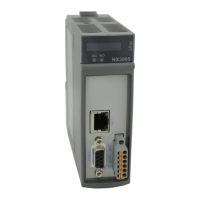6. REDUNDANCY WITH NX3030 CPU
6.2.2.1. NX5001 Modules Addition for PROFIBUS Networks
A redundant PLC is up to until four NX5001 modules for PROFIBUS networks usage. Each network can be single or
redundant. In case the PROFIBUS “n” (being “n” a number between 1 and 4) be redundant, the two networks that belongs to
this are named PROFIBUS “n” A and PROFIBUS “n” B. In case the PROFIBUS “n” be single, the network that belongs to it
will be named PROFIBUS “n” A.
To create a redundant PROFIBUS network, must be inserted two NX5001 modules in each half-cluster. To create a simple
PROFIBUS network, simply insert a NX5001 module in each half-cluster. Thus, it can be configured up to four simple
networks, or two redundant networks, or a redundant and two simple. In other cases, fewer than four NX5001 modules
will be needed in each half-cluster. More information about PROFIBUS networks is provided in the PROFIBUS Network
Configuration section.
In Figure 164, there is only one PROFIBUS network (PROFIBUS 1), and the same is redundant (PROFIBUS 1 A and
PROFIBUS 1 B). In this example, therefore, were inserted two NX5001 modules in each half-cluster.
6.2.2.2. NX5000 Modules Addition for Ethernet Networks
It’s possible to insert up to six NX5000 modules in each half-cluster, delivering six additional Ethernet channels, besides
the two Ethernet channels already existent in the NX3030 CPU.
The Ethernet channels can be used in an individual way, or organized in NIC Teaming pairs, which are used to deliver
redundant Ethernet channels, and are described, with more details, in the Redundant Ethernet Networks with NIC Teaming
section.
A typical application for the NX5000 module can be the construction of a redundant HSDN (High Speed Deterministic
Network), for the communication between several redundant CPUs. Through this network, many redundant CPUs can ex-
change messages in a totally segregated network, in order to guarantee determinism and a fast communication. Furthermore,
configuring this network as redundant with NIC Teaming pairs, an excellent availability may be reached. In order to build such
network (redundant HSDN), two NX5000 modules must be inserted in each half-cluster. Figure 164 shows a redundant HSDN
example using two NX5000 modules in each half-cluster.
Applications where input and output modules are connected to Ethernet networks may require extra interface modules
NX5000 to connect to these networks. In these cases, the network that connects the modules of inputs and outputs can be a
simple or redundant network. Furthermore, the interfaces can be configured with the option of generating life failure. In this
case, a network failure will cause a switch-over.
Figure 164 also shows an example with a NX5000 module used in the isolated form (without NIC Teaming redundancy),
inserted at the right side from the other modules in each rack.
6.2.3. NX4010 Module
The NX4010 model, as shows figure below, was conceived in order to provide the interconnection between the two PLCA
and PLCB half-clusters, and also to connect these half-clusters to the redundancy control panel PX2612. For further infor-
mation regarding this module connections, see Interconnections between Half-Clusters and the Redundancy Control Panel
PX2612.
271

